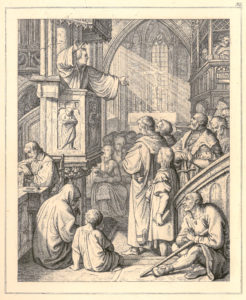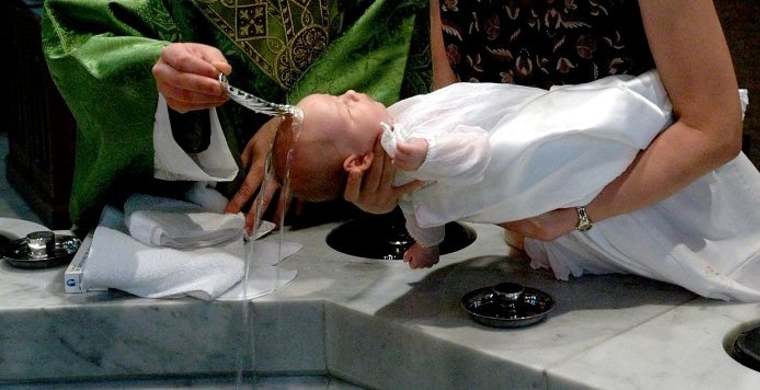by Rev. Dr. Mark Birkholz
A few weeks ago I had the joy of baptizing a baby in my congregation. There were prayers and readings, a candle was lit, the child was wearing white, I asked questions of the parents and sponsors, and in the middle of it all was water and the name of God poured on the child’s head. The last part—water and the Word—is what makes a baptism.[1] In an emergency, a baptism can be very short and simple.[2] But what about all that other stuff? Are these other ceremonies important? What did Luther do?
Martin Luther actually produced two different orders of baptism. The first Order of Baptism was published in 1523. [3] It was basically a translation of the existing Latin rite into German, with a few minor changes, mainly the addition of the Flood Prayer. This order was revised in 1526, primarily by simplifying and shortening it.[4] Known as Luther’s “Little Book on Baptism” (Taufbuchlein) this revision was included in many editions of the Small Catechism, and was very influential in the German church orders for generations to come.
Luther’s original revision of the baptismal order (1523) might seem a little foreign to Lutherans of today. One striking feature is the number of exorcisms and references to the work of the devil.
The priest began by blowing three times under the child’s eyes (an act called the “exsufflation”) and saying, “Depart thou unclean spirit and give room to the Holy Spirit.”[5] The opening prayer implores that God would “break all the snares of the devil with which he is bound.”[6] Following Luther’s Flood Prayer, there was a more extended exorcism of the child, concluding with the words, “I adjure thee, thou unclean spirit, by the name of the + Father and of the + Son and of the + Holy Ghost that thou come out and depart from this servant of God, (Name), for he commands thee, thou miserable one, he who walked upon the sea and stretched forth his hand to sinking Peter.”[7] In his preface to this work, Luther emphasized the seriousness of the exorcisms, “Remember, therefore, that it is no joke to take sides against the devil and not only to drive him away from the little child, but to burden the child with such a mighty and lifelong enemy.”[8]
There were other aspects of this service that are not commonly done today. Near the beginning, salt was placed in the mouth of the child with the words, “(Name) receive the salt of wisdom. May it aid thee to eternal life.”[9] Following the reading of Mark 10:13-16, the priest put spit on his finger and touched the child’s nose and ears, saying, “Ephphatha, that is, Be thou opened. But thou, devil, flee; for God’s judgment cometh speedily.”[10] There were also anointings both before and after the baptism.

König, Gustav Ferdinand Leopold. 1900. The life of Luther in forty-eight historical engravings. St. Louis: Concordia Publishing House.
Overall, Luther’s main concern was that the parents and sponsors hear God’s Word and pray for the one being baptized. He mentions that some of the other “external things” were less important.[11] And so when the 1526 revision was published, many of these rites were gone. Gone was the blowing under the eyelids, the salt, the spit, the anointing and even the baptismal candle. Several prayers were omitted. In general, the whole service was shortened. Previously Luther had left many of these ceremonies in because of “weak consciences,” but three years later he was comfortable removing them.[12]
In our day, some of these practices have come back (e.g. the baptismal candle). Other new ones have been added (e.g. the welcome by the congregation). In Luther’s day it was necessary to pare back the ceremonies a bit, as they were distracting from the baptism itself. Luther found it necessary to emphasize that the water and the Word of God were the main thing in the baptismal rite by reducing the number of ceremonies. In some places the additional ceremonies have been found to be helpful to teach and emphasize what is happening in baptism. “Each generation trims a little, adds a little (extolling is never finished); but always the actual Baptism itself remains the same: ‘one Lord, one faith, one baptism’ (Eph 4:5).”[13]
| Luther’s 1523 Rite | Luther’s 1526 Rite | Lutheran Service Book, p. 268 |
|---|---|---|
| Excorcism with Exsufflation | Exsufflation | Invocation & Admonition from Holy Scripture |
| Sign of the Cross | Sign of the Cross | Name & Sign of the Cross |
| Two Prayers | One Prayer | |
| Giving of Salt | ||
| Flood Prayer | Flood Prayer | Flood Prayer |
| Exorcism | Exorcism (shortened) | |
| Enrolling of Sponsors | ||
| Prayer | ||
| Mark 10:13-16 | Mark 10:13-16 | Mark 10:13-16 |
| Lord’s Prayer w/ Laying on of Hands | Lord’s Prayer w/ Laying on of Hands | Lord’s Prayer w/ Laying on of Hands |
| Ephphatha | ||
| Blessing & Entrance into the Church | Blessing & Entrance into the Church | Blessing & Entrance into the Church |
| Renunciation of the Devil | Renunciation of the Devil | Renunciation of the Devil |
| Profession of Faith | Profession of Faith | Profession of Faith |
| Anointing on Chest & Back | ||
| Declaration of Intent | Declaration of Intent | Declaration of Intent |
| Baptism | Baptism | Baptism |
| Anointing on Head & Peace | Blessing | |
| White Garment | White Garment | White Garment |
| Baptismal Candle | Baptismal Candle | |
| Welcome | ||
| Prayer & Peace |
The Rev. Dr. Mark Birkholz is pastor of Faith Lutheran Church, Oak Lawn, Ill.
[1] Small Catechism IV:1.
[2] See “Holy Baptism: In Cases of Emergency,” Lutheran Service Book, p. 1023.
[3] LW 53:95-103.
[4] LW 53:106-109.
[5] LW 53:96. These words are retained with the sign of the cross and the triune name in the “Alternate Form of Holy Baptism” found in the Lutheran Service Book Agenda, p. 13.
[6] LW 53:96.
[7] LW 53:98.
[8] LW 53:102
[9] LW 53:97.
[10] LW 53:99.
[11] LW 53:102
[12] LW 53: 105-106.
[13] Norman E. Nagel, “Holy Baptism,” in Lutheran Worship: History and Practice, Fred. L. Precht, ed., St. Louis: Concordia, 1993, p. 287.
